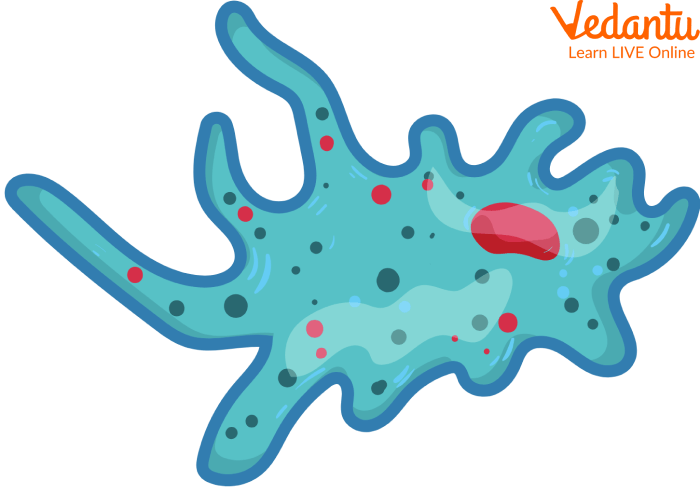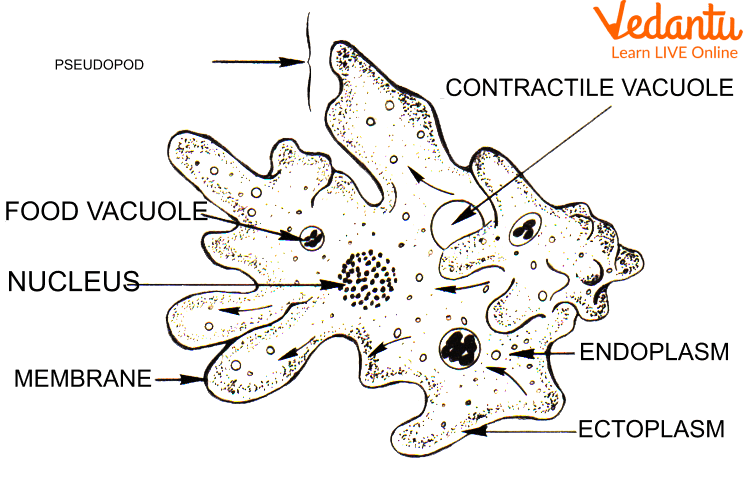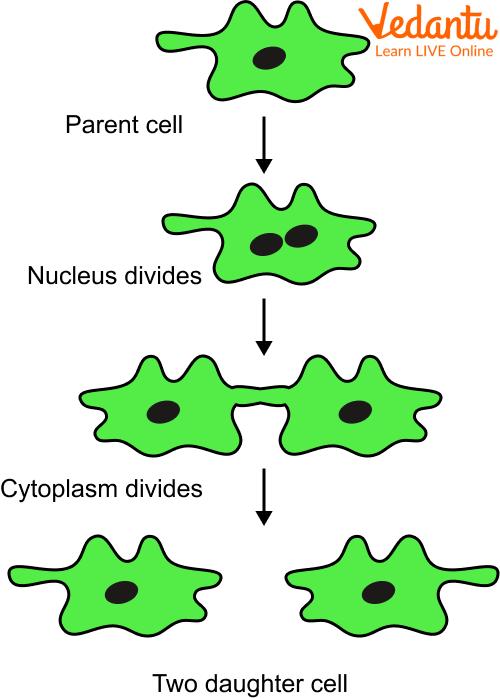




How Does an Amoeba Live and Move?
Amoeba are the simplest form of life and are found in oceans, streams, lakes, ponds, and wet soil. The word amoeba is derived from the Greek word amoibe which means change. Amoeba live in a changing environment where they must adapt to survive. Amoeba are single-celled organisms that can reproduce by simple division. This means that, instead of replicating in the same manner as more complex cells, amoeba reproduces by splitting into two that duplicate all of the original cell's genetic info. In this article, you will learn about the amoeba structure and function, as well as amoeba features. And in the end, we will learn about some facts about amoeba.

Amoeba
What is Amoeba?
Amoeba is a single-celled organism with the ability to change shape. They are typically found in bodies of water such as ponds, lakes, and slow-moving rivers. These unicellular organisms can sometimes make their way inside the human body and cause a variety of ailments. One of the first reports mentioning amoebas dates back to the 18th century. In 1755, a German naturalist called August Johann Rosel von Rosenhof discovered an amoeba.
Amoeba Structure and Function
Amoeba is a shapeless and colourless single-celled microorganism. It has a jelly-like structure, and it changes its shape. Its body is asymmetrical in shape. Its size is very small and can only be seen under the microscope. Its size ranges from $\dfrac{1}{20}$ mm to 0.1 mm.
If you closely look at the amoeba structure, you will see finger-like projections called pseudopods (pseudopodia), which help in the movement and as well as in intake of food. The pseudopods are the extensions of the cytoplasm.
Amoeba also contains other cell organelles such as mitochondria, Golgi apparatus, and fat globules.
Below is a labelled amoeba diagram:

Parts of Amoeba
Parts of Amoeba
The cell of amoeba consists of the following parts:
Cell Membrane: This is n layer of protein and fat that surrounds the amoeba. It allows the flow of substances in and out of the cell.
Nucleus: It is the brain of the Amoeba. It contains genetic material for its growth and manages Amoeba's whole functioning.
Vacuoles: These are air sacs in the cytoplasm of Amoeba. There are three types of vacuole in Amoeba, each carrying out different functions.
i. Contractile Vacuole: Contractile (they can contract and expand) vacuoles regulate the osmotic pressure by pumping water out of the cell through a process called osmoregulation.
ii. Food Vacuole: These are non-contractile (fixed shape) and are in different sizes. These contain food ingested by the Amoeba.
iii. Water Globules: These are small, colourless, noncontractile spherical filled with water.
Cytoplasm: This is a gel-like material that contains all the organelles of the Amoeba.
Pseudopods: These are finger-like projections that help the Amoeba move about and grab hold of food particles.
Interesting Facts About Amoeba
Amoeba is a fascinating organism. Let us have a look at some of the interesting facts about Amoeba.
Amoeba belongs to the genus Protozoa, which are unicellular eukaryotes with membrane-bound cell organelles.
Augustus Johann Rosel von Rosenhof first discovered it in 1757.
The process of breathing in amoeba is done through the cell membrane.
Amoeba consumes food through the process of phagocytosis.
The process of excretion and removal of waste is done through the contractile vacuole.
Amoebas reproduce by dividing into two cells, and they can also form cysts when conditions are unfavourable.

Reproduction in Amoeba
Some amoebas are parasitic, thereby causing harm to humans and animals. For example, Entamoeba histolytica causes amoebiasis.
Amoeba turns into a rigid ball called an Amoebic cyst in unfavourable weather conditions.
Amoebas reproduce asexually either by mitosis or cytokinesis.
Amoebas are found in terrestrial as well as aquatic habitats.
Amoeba usually eats other bacteria and microbes.
Digestion in amoeba takes place within the cell itself.
Summary
Amoebas are single-celled organisms that are found in all types of environments. They are able to move and change shape, and they feed on other small organisms. It is classified as a protozoan and can be found in nearly all environments on Earth. The amoeba has a variety of different shapes and sizes, and its internal structure includes several organelles that help it to function properly. Although they are very simple creatures, amoebas play an important role in the food chain and perform many vital functions in the ecosystem.
FAQs on Amoeba: Structure, Function, and Parts Detailed Guide
1. What is an Amoeba?
An Amoeba is a unicellular organism belonging to the Kingdom Protista. It is a eukaryote, meaning it has a true nucleus and other membrane-bound organelles. Its most distinct feature is its ability to constantly change its shape by extending and retracting temporary projections called pseudopodia, or "false feet."
2. Where are Amoebas typically found?
Amoebas are commonly found in aquatic environments. Their natural habitats include freshwater bodies like ponds, lakes, and slow-moving rivers, as well as in moist soil and decaying organic matter. Some species can also live as parasites in animals, including humans.
3. What are the main parts of an Amoeba cell?
The main parts of an Amoeba cell and their functions are:
Cell Membrane: A thin outer layer that holds the cell together and controls the passage of substances.
Cytoplasm: The jelly-like substance that fills the cell and contains all the organelles.
Nucleus: The 'control centre' of the cell that contains the genetic material and regulates cell activities like growth and reproduction.
Contractile Vacuole: An organelle that collects and expels excess water from the cell to maintain water balance (osmoregulation).
Food Vacuole: A temporary sac that forms around a food particle to digest it using enzymes.
4. How does an Amoeba's ability to change shape help it survive?
The ability to change shape is crucial for an Amoeba's survival for two main reasons. Firstly, it allows for locomotion, where the Amoeba extends its pseudopodia in a direction and the rest of the cell flows into it. Secondly, it is essential for feeding through a process called phagocytosis. The Amoeba extends its pseudopodia to surround and engulf food particles, forming a food vacuole for digestion.
5. How does an Amoeba reproduce?
Amoeba primarily reproduces asexually through a method called binary fission. This process occurs under favourable conditions where the parent cell divides into two identical daughter cells. The process involves the division of the nucleus first (karyokinesis), followed by the division of the cytoplasm (cytokinesis), resulting in two smaller, genetically identical Amoebae.
6. Why is an Amoeba classified as a protist and not as a bacterium, virus, or fungus?
An Amoeba is classified as a protist because of key differences with other microorganisms:
Vs. Bacteria: Amoeba is a eukaryote with a membrane-bound nucleus, while bacteria are prokaryotes that lack a true nucleus.
Vs. Virus: Amoeba is a living, self-replicating cell. A virus is non-cellular and requires a host cell to reproduce.
Vs. Fungi: Amoeba lacks a rigid cell wall, which is present in fungi (made of chitin). It also ingests its food, whereas fungi typically absorb nutrients from their surroundings.
Because it is a unicellular eukaryote that doesn't fit into the animal, plant, or fungi kingdoms, it is placed in Kingdom Protista.
7. Are all Amoebas harmful to humans?
No, most species of Amoeba are harmless and play a beneficial role in the environment by feeding on bacteria and recycling nutrients. However, a few species are pathogenic and can cause diseases in humans. For example, Entamoeba histolytica can cause amebiasis (amoebic dysentery), and Naegleria fowleri can cause a rare but severe brain infection.
8. What is the ecological importance of Amoeba?
Amoebas play a significant role in maintaining ecological balance. They are an important part of the microbial food web, acting as predators that control bacterial populations. By consuming bacteria and decaying organic matter, they help in nutrient cycling in soil and water ecosystems, making essential nutrients available for other organisms like plants.









